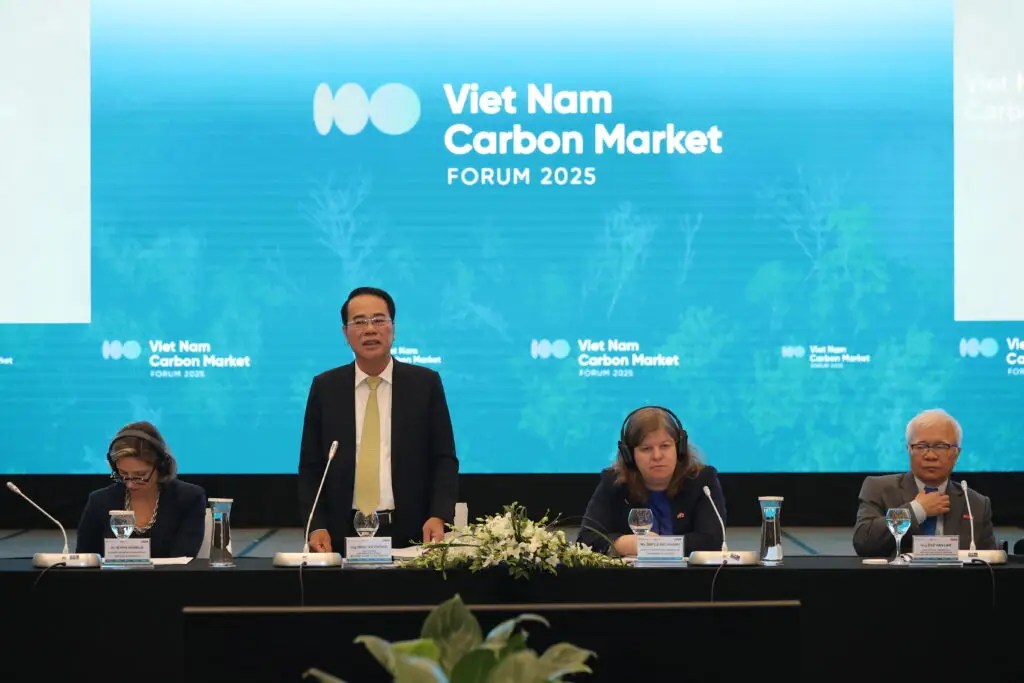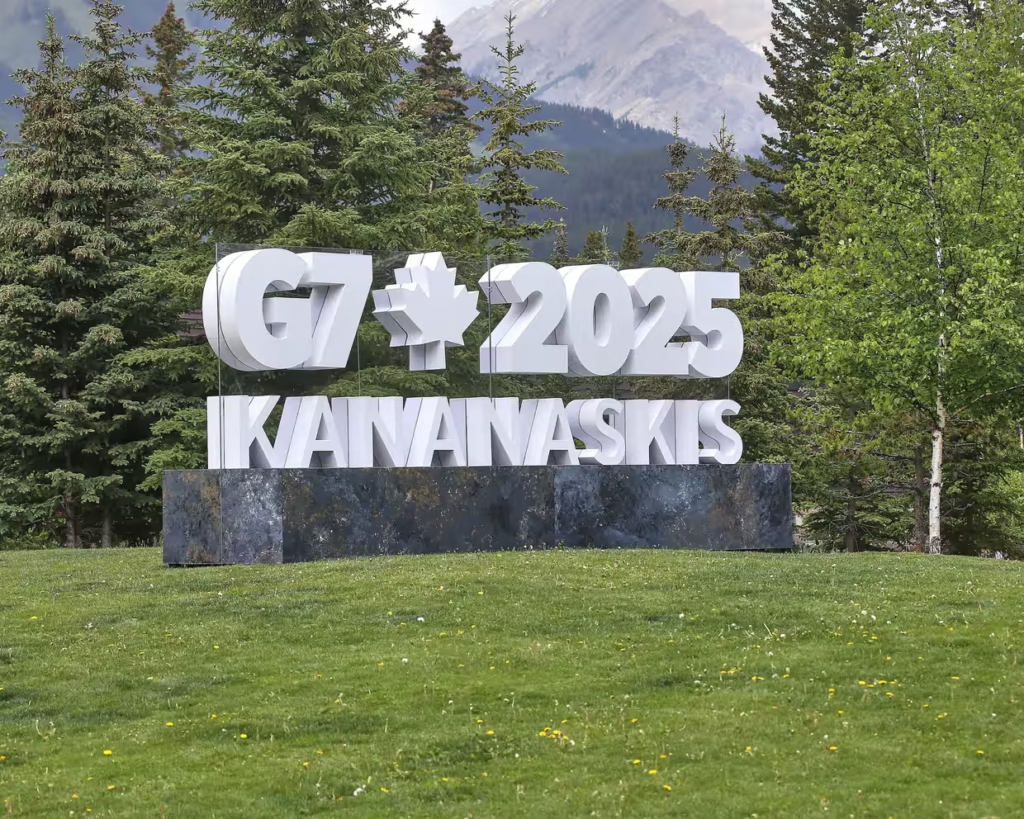Climate Change Crisis: Unmasking the Alarming Truth Behind Today’s Top 10 Global Headlines

This week’s news headlines cover a mix of climate change events, policy changes, and world affairs.
- Countries agreed to boost the UN climate budget
- extreme wildfires in Canada threaten the G7 summit
- London’s Climate Week saw record attendance as US policy shifts caused a split
- China expanded flood compensation after record rain
- Rwanda and Congo signed a US-brokered peace deal tied to mineral resources
- Vietnam launched its first carbon trading market; the US and China struck a deal to resume rare earth exports
- President Trump brokered a ceasefire in the Israel-Iran conflict (halting a short war) while refusing a nuclear incentive deal
- Athens baked under a 40°C heatwave
- Flash flood in Pakistan’s Swat Valley killed Eighteen.
- Each of these stories has a sustainability angle – from climate change effects to green technology.
1. Countries Boost UN Budget for Climate Change by 10%

📸 Photo credit: Kiara Worth / IISD-ENB | Source: Reccessary.com
🙏 Special thanks to IISD-ENB and photographer Kiara Worth for capturing this pivotal moment in international climate negotiations.
Governments at UN climate Change talks in Bonn agreed to raise the climate body’s core budget to €81.5 million for 2026-27, a 10% increase from the previous term. Nearly 200 countries – from Japan and Saudi Arabia to Fiji – signed off on the deal despite cuts at other UN agencies. Notably, China and the US (despite the U.S. absence from talks) will cover larger shares (20% and 22% respectively). This higher funding shows countries still value coordinated climate action even as some governments (like the US) have cut climate aid.
Environmental Angle: More funding for the UNFCCC (the UN climate secretariat) means stronger support for global climate programs (like the Paris climate deal). It signals continued commitment to fight climate change even amid political shifts. In simple terms, the carbon budget (how much CO2 we can emit) is running out fast, so we need every country to pitch in. This budget boost can help poorer countries adapt to warming, protect forests and oceans, and develop clean energy.
Insights: Governments finally reaffirmed that climate change is a priority. This cooperative step is positive. It underscores that climate action requires steady funding – a lesson after past funding shortfalls. The willingness of China and others to pay more suggests climate goals may survive U.S. rollbacks. However, the US quitting the Paris deal and cutting support means others (like Bloomberg Philanthropies) are covering US pledges. If major economies rejoin global climate efforts, that could accelerate clean energy worldwide.
What You Can Do: Pressure your leaders to fund climate solutions. Ask local reps or international bodies to support climate programs. Support charities or groups that finance green projects. Even as U.S. aid falls, private and international funds can fill gaps. Every citizen can advocate for national budgets or taxes that invest in renewable energy, tree planting, and flood defenses – key tools to fight climate change.
2. Canadian Wildfires Cast Smoke Over G7 Summit Intensifying Climate Change

Canada’s devastating wildfire season – its second-worst on record – threatened even the G7 leaders’ mountain summit. By mid-June, 225 fires were burning across Canada (120 out of control). Though the G7 meeting was in western Alberta (Kananaskis Country), smoke from raging blazes in British Columbia and northern Alberta blew toward Calgary, the closest city. Officials warned of poor air quality, and thousands of Canadians were evacuated from dozens of communities. The wildfires had already consumed 3.7 million hectares (9.1 million acres) – huge fuel for more smoke.
Environmental Angle: Scientists agree climate change is making wildfires worse. Hotter summers and earlier snowmelts dry out forests, and extreme heat and drought provide tinder for lightning-started fires. What’s new is that smoke clouds crossed international boundaries: Canadian fires were already affecting air quality in eastern US, highlighting how climate impacts don’t stay local. This story shows climate change acting like a down payment on disaster – each degree of warming piles fuel on future wildfires.
Insights: We saw world leaders directly confronted by climate risk in real time. The G7 summit had to plan for fire safety and health risks (smoke and tornado warnings) even as leaders discussed economy and security. It’s a dramatic reminder: we cannot ignore climate change even when making big policy decisions. The president of Canada and his disaster officials publicly said climate change is to blame for the record fires. The summit itself could highlight global climate cooperation (perhaps one reason it was moved to this region, to showcase how climate affects everyone).
What You Can Do: Support better forest management and firefighting resources. At home, reduce your own fire risk (e.g., clear brush near houses). Back climate action to slow warming – less global warming means fewer megafires. Consider donating to relief groups helping wildfire victims. And stay informed about smoke advisories; personal habits (like using masks or air filters) can protect health when air quality is bad.
3. London Climate Week Draws Record Crowds

Photo Credit: © Euronews / Original Source
Thank you to Euronews for documenting and sharing this vital climate moment.
London’s Climate Action Week (June 20–27) saw an enormous turnout. Organizers held 700+ events attracting over 45,000 attendees – more than double last year. Much of the credit goes to Britain’s strong climate policies and relaxed rules for international visitors. By contrast, the upcoming New York Climate Week in September faces hurdles: tighter entry visa rules and the U.S. government’s climate rollback have discouraged foreign participants. One attendee noted that many groups prefer London’s open environment to the more “challenging” New York event under President Trump.
Environmental Angle: This illustrates how policy and politics influence climate diplomacy. The surge in London’s event is tied to climate change urgency and differences between governments. Britain’s politicians and business leaders (e.g. Energy Secretary Miliband) have been loud about making the UK a “clean energy superpower”. Meanwhile, the US is said to have exited the Paris Agreement, cut development aid and green subsidies. London therefore became the place “you can talk frankly” about climate with open governments. Big in-person discussions can spark new climate solutions – for example, investors pledge to buy more green tech during these forums.
Insights: The contrast between the two climate weeks is stark. London’s success suggests that if a country shows real leadership on climate, it attracts innovation and investment. Speaker Hindou Oumarou Ibrahim said London allowed frank discussion of topics (like indigenous land rights, social justice and climate) without fear. Her point: climate events don’t happen in a vacuum. Politics matter. As the world debates how to reach net-zero, places with open policies will gain influence and jobs in renewables and conservation.
What You Can Do: Take part in (or follow news from) local climate conferences or forums. Pressure national leaders: ask them to attend global climate talks and commit to emissions cuts. Support businesses at home that invest in green technology, and back policies like carbon taxes or clean energy incentives. Public attention (e.g. attending rallies or online events) helps ensure momentum from conferences turns into real action against climate change.
4. China Expands Flood Compensation Amid Extreme Rain

Original Source Link: Al Arabiya – July 3, 2024
Used under fair use for educational and editorial purposes.
Thank you to Al Arabiya for providing this impactful visual.
China has faced unprecedented summer rainfall this year. In the past week alone, record rain in central China forced officials to deliberately flood farmlands and villages to protect big cities. In response, Beijing expanded support for people hit by its flood diversion schemes. The new rules guarantee more government compensation for those whose homes, farms or livestock are sacrificed to hold back swollen rivers. For example, authorities will now pay for livestock losses and cover 70% (instead of a variable share) of all compensation costs.
Environmental Angle: Climate change is making storms and extreme rainfall more common and severe. China’s government explicitly linked this policy to growing “extreme rainfall” events. The vast network of flood diversion areas (98 sites across big river basins) is a drastic adaptation: authorities actually pour floodwaters onto less developed lands to save cities (as happened in 2023 near Beijing). This highlights two things: first, climate change is already straining communities, forcing governments to choose which areas to protect. Second, it shows a tradeoff – using rural or agricultural land as flood “buffers” can help cities, but it creates social tensions about fairness.
Insights: China’s move is pragmatic: the government knows climate-driven floods are here to stay, so it’s trying to build trust by compensating victims better. This could ease tension and encourage cooperation. For sustainability, it signals how countries might invest in adaptation (floodwalls, early warning, relocations) as much as emissions cuts. However, it also shows the human cost of climate change: families losing homes or farmland to save others’ property is an unfortunate reality of our warming world.
What You Can Do: Support international climate funds that help poorer areas adapt to extreme weather. At an individual level, stay informed about flood risks in your region – climate change means storms can be unpredictable. If you live near rivers or coasts, help local governments or community groups plan evacuation routes and resilient infrastructure. Donate to relief charities that assist flood victims. Finally, reduce your own emissions (e.g. use less coal or oil) to help slow the climate warming that causes these record rains.
5. Rwanda-Congo Peace Deal with Mineral Goals

Rwanda and the Democratic Republic of Congo signed a U.S.-brokered peace accord on June 27. This agreement aims to end a long-running conflict in eastern Congo. It includes Rwandan troop withdrawal and a framework for billions in investment into the region’s economy. Crucially, the deal also impacts mineral rights: eastern Congo is rich in tantalum, gold, cobalt, copper, lithium and other resources, all vital for batteries, electronics and green tech. The U.S. president who brokered it noted that the U.S. would benefit from securing some of Congo’s mineral supply.
Environmental Angle: Peace and environment often go hand-in-hand. Armed conflict can destroy forests and water supplies, whereas stability can allow better management of nature. Here, the minerals at issue (cobalt, lithium, etc.) are green economy materials. They power electric cars and store renewable energy. Thus a peaceful deal could boost the ethical mining of these minerals for climate-friendly technology. On the other hand, if not managed sustainably, mining can harm ecosystems (deforestation, pollution).
Insights: This story links war, resources and climate. Ending violence is good for people and forests alike. If the U.S. and others invest in responsible mining and battery plants, it could advance the global clean energy transition. But it’s a cautionary tale: rich countries are eyeing African minerals to meet their climate goals. The positive side is that the peace deal could bring development (roads, energy, jobs) which often raises environmental standards too. Still, activists will need to ensure mining doesn’t devastate local forests or exploit workers.
What You Can Do: Support fair-trade and ethical sourcing: buy electronics or EVs from companies that source minerals responsibly. Pressure governments to tie aid or investment to strong environmental safeguards in mining zones. Contribute to NGOs working in the Congo on reforestation or clean mining. More broadly, reducing demand for new minerals through recycling and sharing (e.g. public transport instead of buying a car) helps ease pressure on such regions.
6. Vietnam Launches National Carbon Market

📷 Photo courtesy of Klinova Vietnam – thank you for documenting this important climate milestone.
Vietnam officially launched its pilot emissions trading scheme (ETS) on June 11. In this “cap-and-trade” system, major polluters (steel, cement, thermal power plants – about half of Vietnam’s emissions) must buy permits for each ton of CO₂ they emit. For now, many free allowances will be given, easing companies in. The scheme will grow over time: by 2029 it covers 50% of emissions, and later sectors like transportation and buildings will join. Vietnam aims to reach net-zero by 2050, so carbon pricing is a key tool.
Environmental Angle: Carbon markets are market-based ways to reduce climate change pollution. By putting a price on carbon, the ETS makes it more costly to pollute than to invest in cleaner technology. Vietnam’s move is significant: it shows emerging economies are adopting tools that Europe and China use. In simpler terms, this means coal-fired factories will need to factor in the “climate cost” of their CO₂. Over time, it should encourage companies to save energy or use renewables (the most direct way to reduce emissions in cement, steel and energy, which Vietnam dramatically increased last year).
Insights: Launching the ETS is a positive step but not an overnight fix. Because so many permits are free initially, early emissions may not drop much. Still, this “learning period” gives companies time to adapt. For climate, it signals Vietnam’s commitment to green growth. For example, coal power surged 18% last year, so pricing CO₂ will gradually discourage that. This is exactly what climate economists recommend: starting slow but clearly moving toward full carbon accountability.
What You Can Do: Follow Vietnam’s market as a model. If your country lacks carbon pricing, advocate for one – many developed nations now have carbon taxes or cap-and-trade. Businesses and citizens can support cleaner alternatives: in Vietnam’s case, consumers can push for more renewable energy or electric vehicles. Globally, buying products with lower carbon footprints (e.g. using less steel or cement in construction, recycling, using energy-efficient appliances) reduces demand for coal power and heavy industry. Every kilo of CO₂ saved today widens our planet’s remaining carbon budget for meeting climate goals.
7. U.S.-China Deal Restores Rare Earth Exports

After weeks of trade tensions, U.S. Treasury Secretary Scott Bessent announced on June 27 that China would resume exporting critical minerals and magnets (rare earths) to the U.S.. These materials had been blocked by China as retaliation for new U.S. tariffs in April. The dispute stalled supply chains for products like electric vehicles, military hardware and electronics. An agreement – partly brokered by a Trump-Xi phone call – means future shipments of rare earth minerals and magnets (used in motors, batteries, electronics) will flow again.
Environmental Angle: Rare earth minerals are crucial for green technology. Neodymium, dysprosium, lithium, etc. are needed in EV motors, wind turbines and solar panels. Without a steady supply, renewable projects and electric cars stall. On the flip side, mining rare earths can be environmentally damaging (soil and water pollution if mismanaged). The deal is mostly positive: it secures green tech supply chains for clean energy tools. But it also highlights the geopolitical side of sustainability – countries are now fighting trade wars over climate solution materials.
Insights: This story shows that “climate technology” and national security overlap. Presidents notice that if their rival controls key minerals, that’s a vulnerability. A stable rare earth market helps investors and manufacturers plan new clean energy projects. However, it reminds us to diversify: even with China reopening exports, the U.S. and others are exploring ways to mine domestically or recycle these minerals sustainably. For example, reusing magnets from old electronics or finding alternative materials can reduce dependence.
What You Can Do: Support sustainable sourcing. When buying electronics or EVs, look for companies that certify their supply chains. Encourage recycling programs (e.g., drop off old phones or batteries for proper processing). On a bigger scale, back policies or funds that invest in domestic clean-mining projects or alternatives to rare earth usage. Reducing overall consumption (like using public transit instead of multiple cars, sharing tools) also eases pressure on these critical resources.
8. Trump Brokered Ceasefire in Israel-Iran Skirmish

In a surprise turn, U.S. President Donald Trump announced on June 24 a ceasefire between Israel and Iran after a 12-day air war. The conflict began when Israel attacked Iranian targets on June 13, provoking Iran to launch missiles and drones into Israel. Trump credited the U.S. with ending the war, and simultaneously denied reports of a $30 billion U.S. aid deal for Iran’s nuclear power. In fact, he called that idea a “fake news” hoax on social media. The key point: the brief war ended with U.S. mediation, not a nuclear incentive.
Environmental Angle: War has huge environmental costs (burned land, pollution, oil facility damage). Stopping the fighting is clearly positive. Also, the mention of a civilian nuclear deal touches climate issues: if Iran had gotten civilian nuclear aid in exchange for stopping enrichment, that could have meant more nuclear energy (a low-carbon power source) in its energy mix. Trump’s refusal of that deal hints at lost opportunity for a non-combustion energy boost. On the other hand, the war itself raised alarms globally about the risk of nuclear escalation.
Insights: This story is complex. Ending a war is good for all, but the surrounding politics matter. If more countries back out of climate-friendly paths (like nuclear energy or emissions cuts), that’s worrying. The bigger takeaway is that peace is necessary for focusing on climate. Resources spent on conflict could have gone to renewable energy or disaster relief. Many experts say that every year of peace and stability allows more investment in sustainable development. The ceasefire means the Middle East can (hopefully) turn attention back to issues like water scarcity and solar power, instead of war.
What You Can Do: Advocate for diplomacy and conflict resolution – peace is good for people and the planet. Support organizations that work on post-conflict environmental recovery. Encourage your leaders to resume dialogue on climate cooperation with all countries (even Iran and Israel). On an individual level, reducing waste (like avoiding single-use plastics even in crisis situations) and choosing sustainable energy for your home helps ensure fewer resources are diverted to war and more to clean future.
9. Athens Heatwave: 40°C Record Temperatures

📷 Image credit: Hürriyet
On June 27, Athens sweltered under a heatwave of over 40°C (104°F). Tourists at the Acropolis pantomimed in front of the ruins, and locals hid indoors or under umbrellas. Greece’s authorities took rare precautions: they banned outdoor construction work and advised remote work for delivery drivers and couriers between 09:00 and 14:00 UTC. This kind of heat is exceptional even for Mediterranean summer, and it came just before Greek wildfires began a few days later.
Environmental Angle: Scientists agree that climate change is making summers hotter and heatwaves more intense. The Reuters report notes that while Greece is used to hot summers, in recent years “climate change has led to longer and more severe heatwaves”, as well as wildfires and floods. In plain terms: global warming raises the baseline temperature, so record highs happen more often. People without air conditioning suffer, and ecosystems (trees, wildlife) can die under extreme heat.
Insights: This story is a vivid example of climate change in action. Everyday activities like sightseeing became dangerous. City officials had to create heat relief centers for the elderly. It shows why adaptation matters: building design (shaded streets), early warning, and public health measures can save lives. It also hints at the economic toll: lost work hours in the heat, and cooling costs. If temperature records keep falling, tourism and productivity will suffer. On the bright side, such events raise public awareness. A person experiencing 40°C is likely to support climate solutions.
What You Can Do: Prepare for heat waves: stay hydrated, avoid strenuous outdoor work at midday, and check on vulnerable neighbors. Advocate for local cooling centers and green urban planning (planting trees, creating parks that reduce the “urban heat island” effect). Support clean energy – less air pollution can help slightly cool cities. And on policy: urge governments to adopt strong heatwave action plans and climate policies (like emissions cuts) so fewer summers hit extreme temperatures in the future.
10. Pakistan Flash Floods Kill Eighteen Picnic-Goers

Photo courtesy: Lightning News — Used with gratitude and for educational purposes.
A tragic flash flood struck northern Pakistan on June 27. A family was picnicking by the Swat River when suddenly monsoon floodwaters surged. Children playing in the river were swept away, and relatives who jumped in to save them also drowned. Rescue crews recovered nine bodies; some family members are still missing. Authorities said unusually heavy monsoon rains caused the deluge.
Environmental Angle: Monsoon rains have always been part of Pakistan’s climate, but climate change is making storms more extreme and unpredictable. A sudden flash flood like this is often fueled by heavy rain that the ground or rivers can’t absorb quickly enough. Many scientists warn that as the atmosphere warms, it holds more moisture – leading to heavier downpours. In Pakistan (and wider South Asia), heat waves are also intensifying the monsoon cycle, so floods and droughts alternate with more severity.
Insights: This story highlights human vulnerability to climate extremes. A happy outing ended in disaster because nature’s behavior is changing. The Reuters article notes the tragedy but doesn’t explicitly blame climate change – yet the context is clear. Over the past years, Pakistan has seen devastating floods (like in 2022) linked to warming. Going forward, saving lives will require better flood forecasting, warning systems and infrastructure (like river embankments). It also shows the need for community training on emergency response.
What You Can Do: If you live in a flood-prone area, follow local flood warnings and know evacuation routes. Help support or donate to Pakistani relief organizations working on flood rescue and climate resilience. On a wider level, we must reduce greenhouse gases so that extreme rainfall events become less severe over time. Even planting trees and restoring forests upstream (where heavy rain falls) can slow runoff and lessen floods. Personal tips: avoid strolling near swollen rivers during rains, and always supervise children near water – conditions can change in minutes.
Each of these global headlines ties back to climate change one way or another – whether through policy, technology or weather. By understanding the environmental angle of the news, we can see how world events affect Earth’s future. The actions above – from voting green, supporting climate projects, reducing waste, to staying safe in heatwaves and floods – are steps we all can take this week.
Discover more from Ecofriendly Product
Subscribe to get the latest posts sent to your email.

